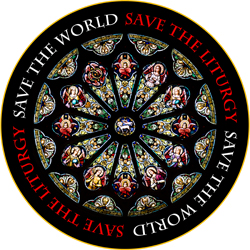Did you ever assist at a Mass that, for what ever reason, continued to occupy your thoughts and your feelings for long afterward?
I have been very fortunate, much superb preaching, much stirring music, much careful and precise prayer, much authentic emotion, much manifest "active love" in my lifetime, far more than liturgies that haunt one for the opposite reasons.
But the one that has all but obsessed me now for a week stands out for... well, for the reason that nothing about it "stands out," utter simplicity*, utter focus, utter simplicity, utter God-ward motion.
It was one single prayer offered to the Father by the Son in the Holy Spirit.
It was seamless.
I like gorgeousness, I like splendor. These are not the same as ostentation, but I have to remind myself at times that Beauty avails Herself of a broad range of aesthetics and styles, so that by the same token minimalism and simplicity are not the same as shabbiness or homeliness.
My tastes are naturally formed somewhat by good experience, nostalgia, fond associations - but I think I can be objective in my judgements, as well, and I think the plain fact is that some styles and aesthetics lend themselves more to liturgical use, are more powerfully able to accomplish the evanglization and catechesis that is required of them.
Any way, my Mass for the Solemnity of the Immaculate Conception just hit that sweet spot. I was travelling, for pete's sake, and it was almost pure chance!
Sometimes I think I'm just to lucky to live. (For LONG, Aunt Scelata! I can hear my squeaky voiced little niece reprimanding me for shortchanging an expression she likes, "2 lucky 2 live 4 long" is how it goes!)
I'll have to write a bit more of it when I can.
.........................................................................
*"Noble simplicity" properly understood - This is as good a definition and concise a description as any: noble simplicity, at least as Winckelmann first defined it, properly
refers to a unity of physical and spiritual elements in a work of art,
and was used by him to refer to classical Greek sculpture, which is a
world apart from the misshapen gnomes that populate OCP clip art. You
could make the case that good Gothic, Baroque or Romanesque has the
quality of noble simplicity.
Subscribe to:
Post Comments (Atom)




No comments:
Post a Comment